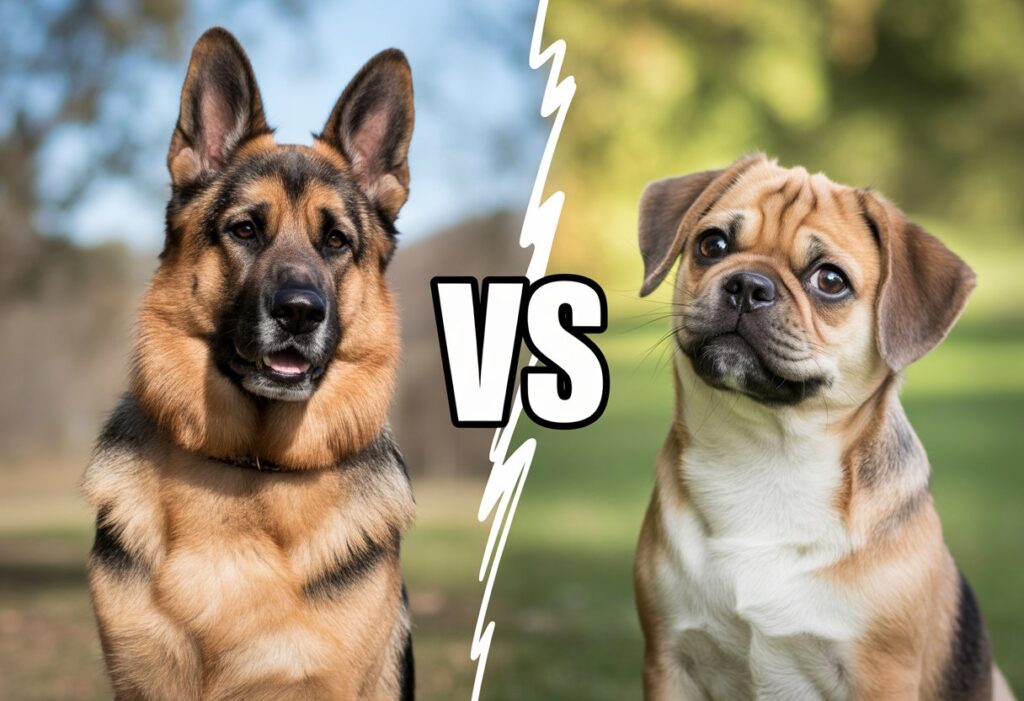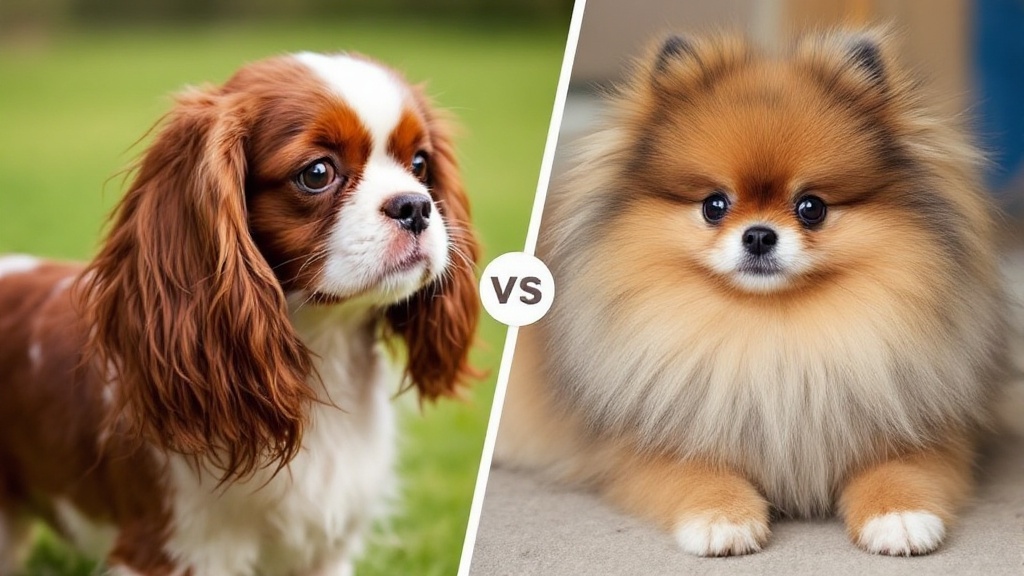Are you stuck between choosing a German Shepherd or a Puggle as your next dog? German Shepherds and Puggles are wildly different in size, looks, energy, and personality, so the right pick really comes down to your lifestyle and what you want from a companion.
Getting to know these differences will help you figure out which one fits better with your home and routine.
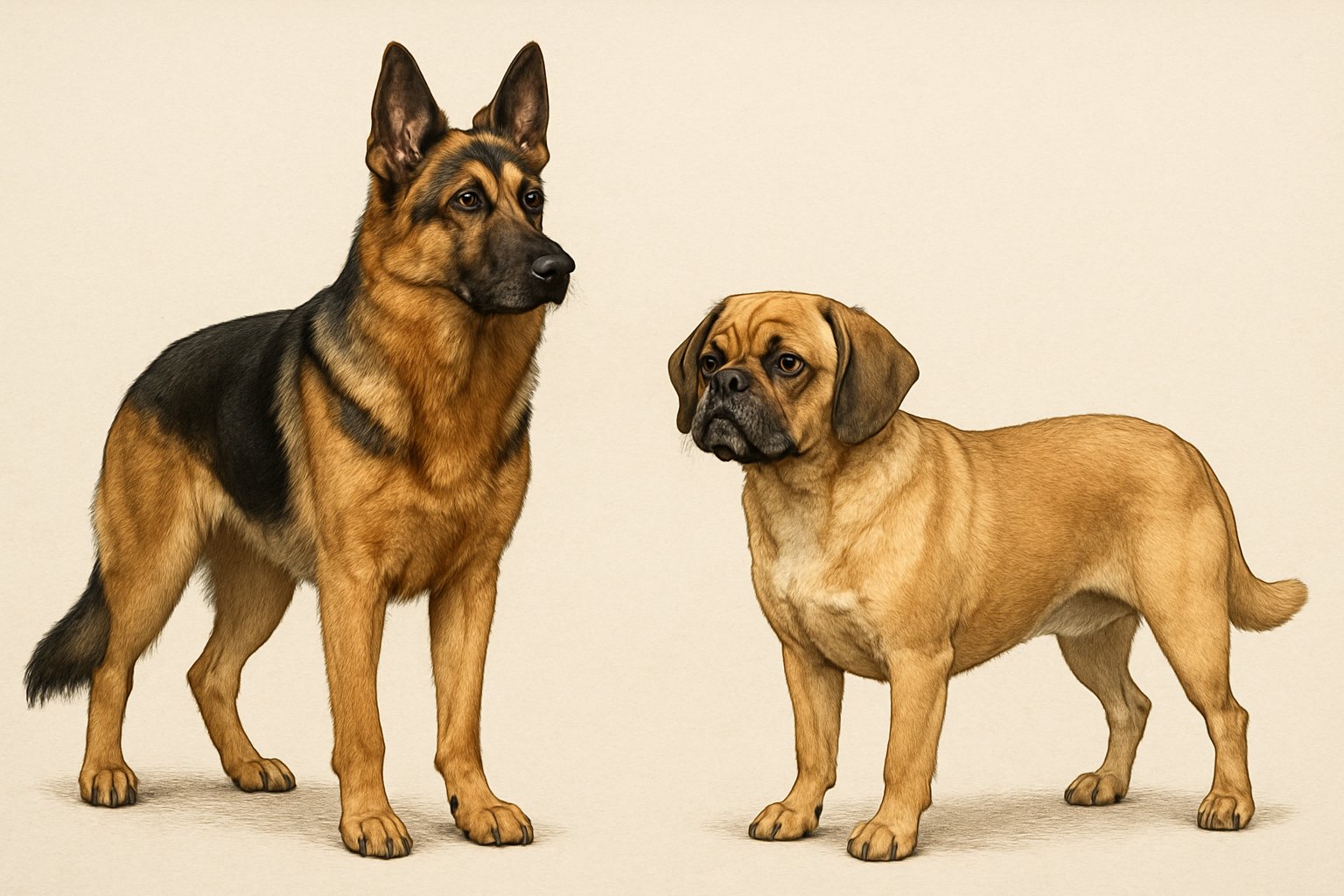
Both breeds make wonderful pets, but their care and exercise needs are far from alike. It’s a good idea to learn about their traits, health, and what daily life actually looks like with each breed before you commit.
Key Takeaways
- German Shepherds and Puggles differ in size, appearance, and personality.
- Each breed has its own needs for exercise, training, and care.
- The best dog for you depends on your lifestyle and what you prefer.
Overview of German Shepherds and Puggles
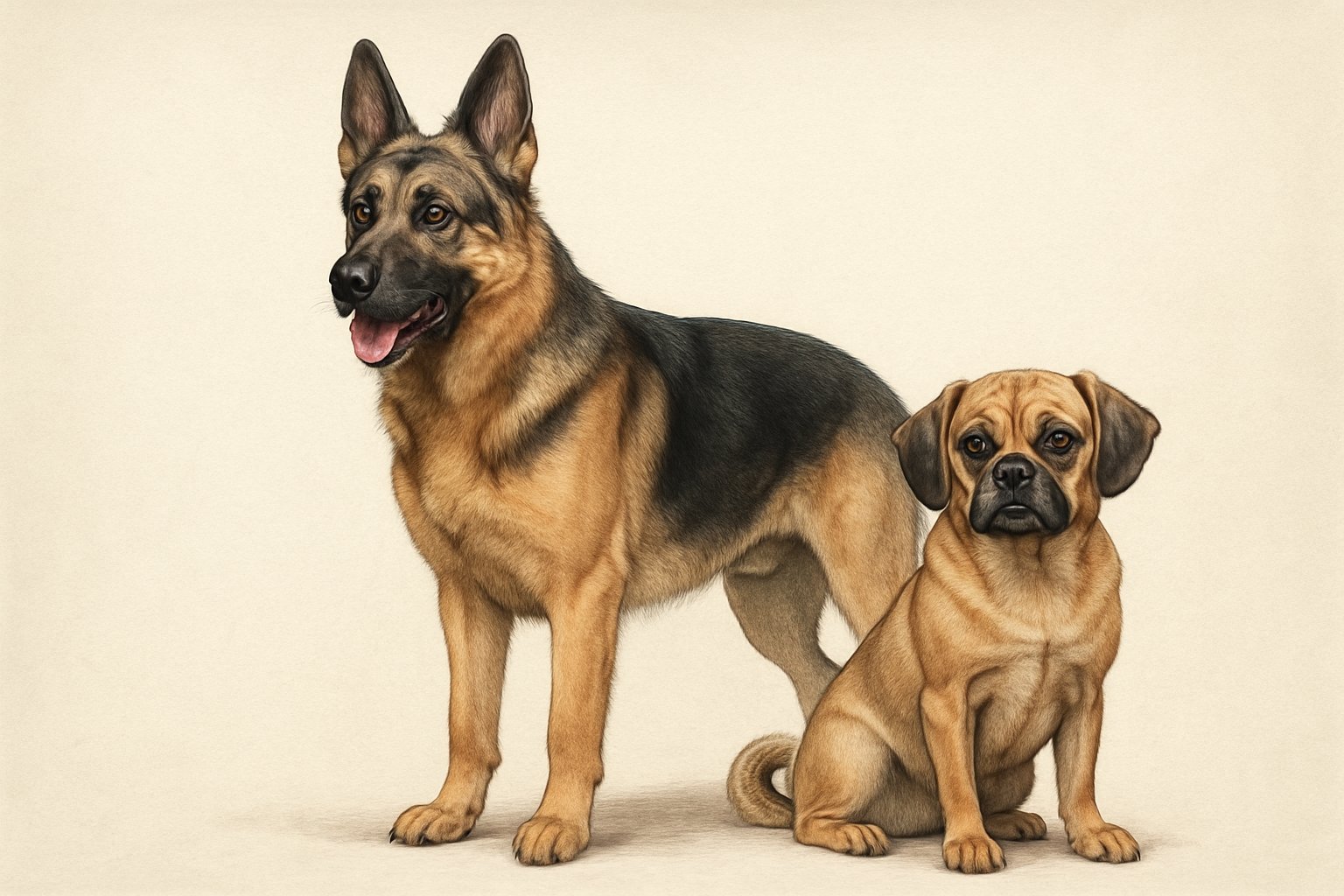
German Shepherds and Puggles really couldn’t be more different. Their origins, looks, and even how they act are shaped by their history.
Origins and History
The German Shepherd started out in Germany in the late 1800s. Captain Max von Stephanitz wanted a working dog that was strong, smart, and loyal.
He bred local herding dogs to create what we now know as the German Shepherd. The breed quickly found work as police, military, and service dogs.
Their brains and trainability made them perfect for all sorts of jobs. Over time, German Shepherds became one of the most recognized working dogs worldwide.
Puggles are a much newer dog breed. They’re a mixed breed, a cross between a Pug and a Beagle.
Breeders in the U.S. started intentionally creating Puggles in the 1980s. The goal was a family-friendly dog with fewer breathing issues than a purebred Pug.
Puggles don’t have a long history or a working background. People love them for their playful, loving personalities and smaller size.
Breed Recognition
The German Shepherd is officially recognized by major dog organizations. The American Kennel Club (AKC), United Kennel Club (UKC), and Federation Cynologique Internationale (FCI) all list the German Shepherd as a standard breed.
Plenty of breed clubs exist to set standards and help owners out. Puggles, on the other hand, aren’t recognized as purebred dogs.
Most kennel clubs, including the AKC and UKC, don’t accept Puggles because they’re a mix. Still, hybrid breed registries like the American Canine Hybrid Club (ACHC) or Designer Breed Registry (DBR) do offer some recognition.
You can register a Puggle with these groups, but the breed isn’t standardized or officially recognized. You probably won’t see Puggles at dog shows or working jobs.
Physical Characteristics and Appearance
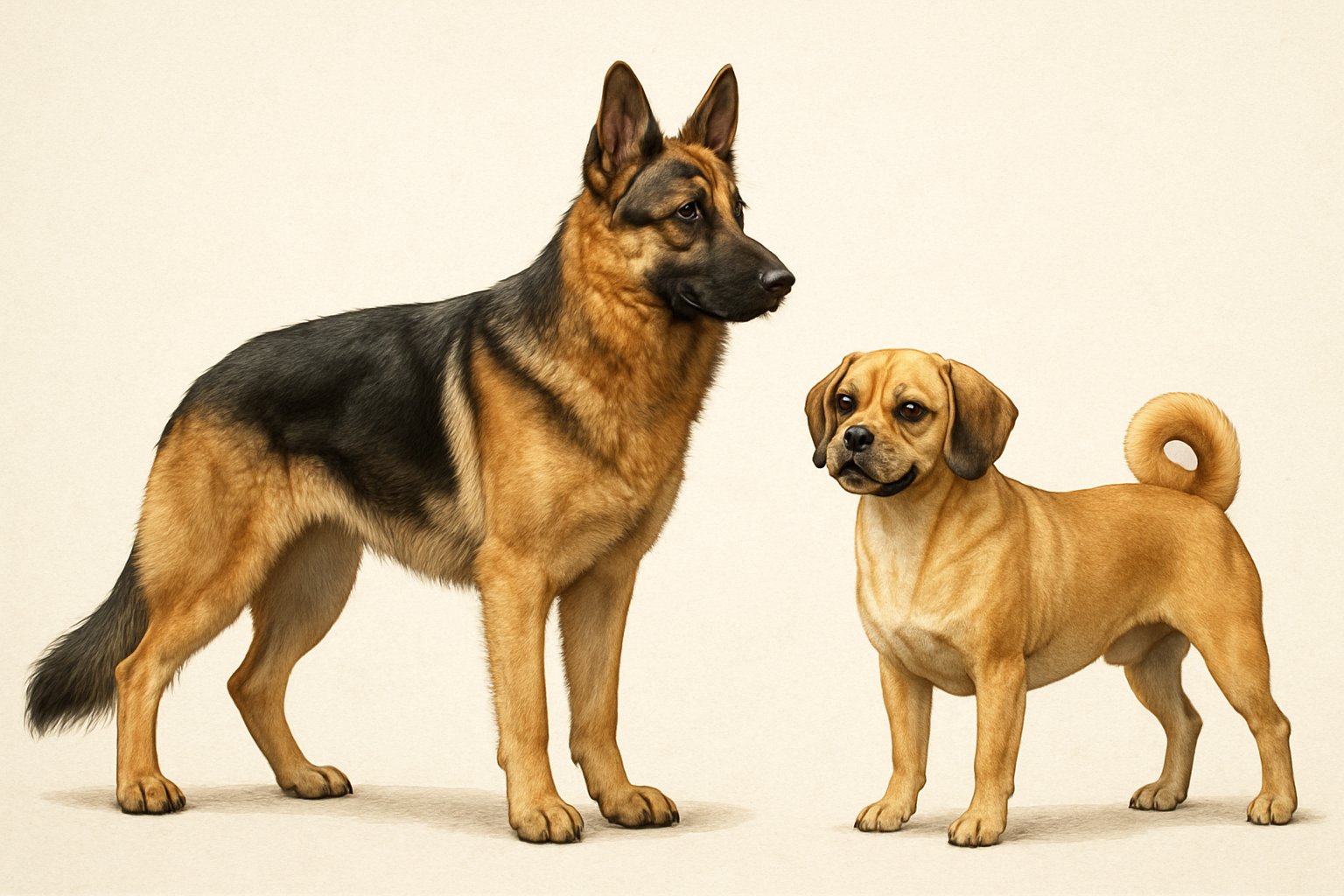
German Shepherds and Puggles really don’t look alike. Their size, build, coat, and standout features set them apart.
Size and Build
German Shepherds are large strong dogs. Most weigh 60–90 pounds and stand about 22–26 inches tall at the shoulder.
They have muscular, long bodies and a straight back, which signals good health. The breed standard values balance and agility, much like other working breeds.
Puggles, a Pug-Beagle mix, are smaller. They usually weigh 15–30 pounds and stand 10–15 inches tall.
Their bodies are compact and sturdy, with shorter legs—kind of like a Basset Hound. Puggles come off as playful and much less intimidating than a German Shepherd.
If you want a large, athletic dog, the German Shepherd might be your pick. For something smaller and easier to handle, a Puggle makes more sense.
Coat and Color
German Shepherds have a double coat that’s dense and straight. The outer layer feels coarse and is medium in length.
Typical colors are black and tan, sable, or all black. Some have liver or blue coats, but those aren’t usually part of the breed standard.
Puggles sport a short, smooth coat like their Pug parent. Their fur can be fawn, tan, black, or a patchy mix.
A darker mask around the face is common, thanks to the Pug side. Both breeds shed moderately, but the German Shepherd needs more grooming.
Coat type affects how much brushing you’ll do—and how much fur ends up on your couch.
Distinctive Features
German Shepherds have a strong, noble head with upright ears and a long muzzle. Their bodies look sleek and athletic, never bulky.
A straight back is key; sloped backs are less ideal for health. Puggles have a much shorter muzzle and might show a few facial wrinkles from the Pug side.
Their ears flop down, and their eyes are big and round. Most Puggles have curled tails and a cheerful, playful look.
You can usually tell these breeds apart by their face shape, ears, and tail.
Temperament and Personality Traits
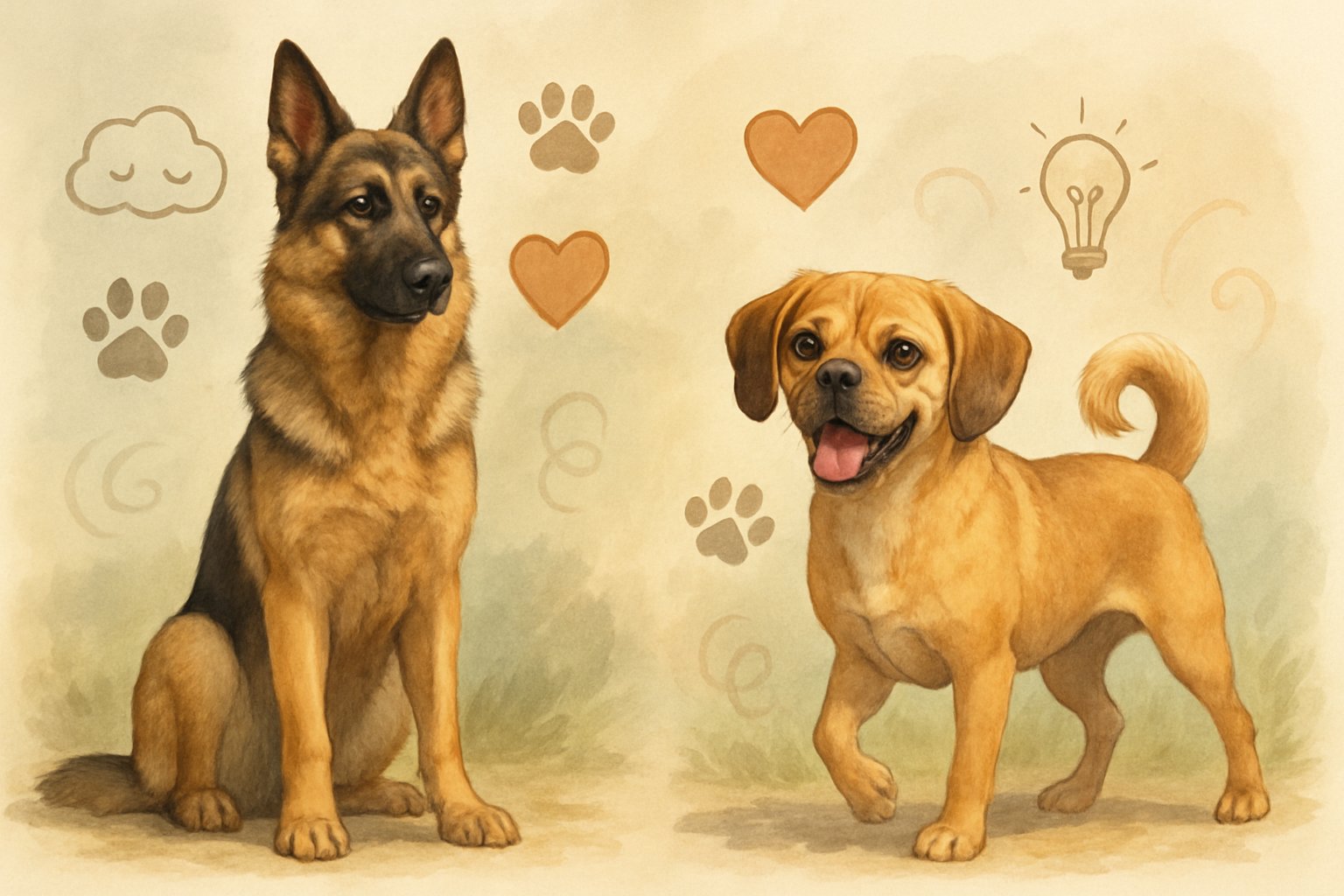
German Shepherds are famous for loyalty, protectiveness, and brains. Puggles are social, outgoing, and playful—usually not aggressive at all.
Social Behavior
German Shepherds tend to be cautious with strangers and can act protective. If you want a guard dog, this breed does the job and bonds tightly with family.
They may not warm up to new people unless you socialize them early. Puggles, being part Beagle and part Pug, love meeting people and rarely act shy.
They fit well in busy homes or apartments and soak up attention. Other breeds like the Saint Bernard or French Bulldog are friendly too, but German Shepherds stand out for their guarding instincts.
If you want a family companion who greets everyone, the Puggle wins out over the Shepherd.
Trainability and Intelligence
German Shepherds are quick studies and love learning. You can teach them basic commands or even advanced stuff.
Police and military handlers often pick this breed for jobs that need focus and discipline. Puggles are smart but sometimes stubborn.
Their Beagle side can distract them, especially if they catch a good scent. Training works best with treats and patience.
Compared to breeds like the English Bulldog or Pomeranian, both German Shepherds and Puggles train well, but Shepherds are more eager to please.
German Shepherds thrive on structure, while Puggles might get bored if training drags on.
Compatibility With Families and Other Pets
German Shepherds do well with families but need early socialization to be good with kids and other pets. They might chase smaller animals because of their herding roots.
If you already have a dog, Shepherds usually get along if raised together. Puggles almost always play nice with children and other pets.
They’re a solid match for multi-pet homes thanks to their easygoing vibe. French Bulldogs and Pugs are also family-friendly, but Puggles might have a slight edge with cats or other dogs because they’re less territorial.
Exercise, Training, and Activity Needs
German Shepherds and Puggles both need daily exercise and mental activity, but the amount and style are worlds apart. If you don’t meet these needs, you’ll probably see some unwanted behavior.
Physical Exercise Requirements
German Shepherds are big, active dogs. They need at least one to two hours of exercise every day.
That might mean long walks, jogging, fetch, or even agility or herding. Without enough exercise, German Shepherds get bored and can turn destructive.
Puggles don’t need as much. Two short walks and some playtime usually do the trick.
Because of their Pug side, Puggles can overheat—so skip long walks in the heat and keep an eye out for heavy breathing.
Here’s a quick comparison:
| Breed | Daily Exercise Time | Best Activities |
|---|---|---|
| German Shepherd | 1-2 hours | Running, fetch, hiking |
| Puggle | 30-45 minutes | Walks, play, games |
Mental Stimulation Needs
German Shepherds are super smart. They need mental challenges as much as physical ones.
They’re happiest when you give them tasks, puzzles, or training sessions. Obedience classes, scent games, or advanced tricks keep them busy.
Puggles need some mental stimulation, too, but not as much. Puzzle toys, treat balls, and simple tricks work well.
Mix up their routine and toss in a new trick now and then to prevent boredom. Use reward-based training for both breeds.
Praise, treats, or toys keep things positive and encourage good habits.
Health Considerations and Lifespan
German Shepherds and Puggles each come with their own health tendencies and life spans. Their backgrounds mean they face different issues, from joint pain to breathing troubles.
Common Health Issues
German Shepherds often struggle with hip and elbow dysplasia, which causes pain and limping. They sometimes get bloat, a dangerous stomach problem, and can have allergies or skin issues.
Puggles may have breathing problems like brachycephalic syndrome from their Pug side. They’re also prone to eye issues, ear infections, and joint problems like luxating patella.
Allergies, obesity, and dental disease pop up, too. French Bulldogs, like Pugs, often have breathing and skin issues.
Big breeds such as Saint Bernards can have heart and severe joint problems. Regular vet visits and early treatment make a real difference.
Ask breeders about health testing and family history before you decide.
Expected Lifespan
German Shepherds usually live 9–13 years. Large breeds like the Saint Bernard often make it to 8–10 years, mainly because of their size and joint or heart issues.
Puggles tend to live 10–15 years, thanks to their mixed background. Many reach their teens.
Smaller breeds like Pugs and French Bulldogs have similar or slightly shorter lifespans if they develop serious health problems. Feeding a balanced diet, keeping your dog at a healthy weight, and regular exercise help extend those years.
Routine health screenings matter for both breeds.
Which Breed Is Right for You?
German Shepherds and Puggles bring different personalities, energy, and care needs to the table. Your daily routine, family size, and living situation will pretty much steer you toward the right fit.
Lifestyle Suitability
A German Shepherd needs lots of daily exercise and space to play. Regular training is a must for them.
If you love hiking, running, or just being outside, a German Shepherd could be your kind of dog. They’re loyal and protective, and they usually click with active folks or families with older kids.
Puggles are smaller, so they need less exercise than German Shepherds. They usually fit right into apartments or smaller homes.
They’re friendly and social, which makes them pretty adaptable for families, singles, or even seniors. If you prefer short walks and want a dog that’s a bit more low-key, a Puggle might be the better fit.
| Breed | Space Needed | Exercise Level | Best For |
|---|---|---|---|
| German Shepherd | Large yard | High | Active families, experienced owners |
| Puggle | Small/medium | Moderate | Small homes, new dog owners |
Factors to Consider Before Choosing
Take a moment to think about how much time you actually spend at home. German Shepherds really don’t like being left alone for long stretches. If they get bored, they’ll probably act out or even get destructive.
These dogs shed a lot and need regular brushing. If anyone in your household has allergies, that’s something you’ll want to consider. Training matters too—German Shepherds are smart, but they can be pretty stubborn.
Puggles, on the other hand, don’t shed as much and need less grooming. But if you leave them alone too long, they might bark up a storm. Since they come from Beagles and Pugs, you might notice they love to dig or can be a bit headstrong.
Before picking a breed, jot down what really matters to you—things like size, energy, or how much time you’ve got for care and training. That’ll make it easier to find the right breed that actually fits your life.

